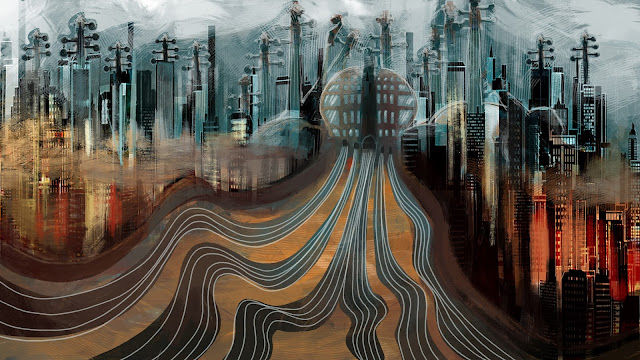The Brass City / The Trombone & Tuba District
Trombone: Brassy, brilliant, powerful, overpowering, solid, tense, penetrating, dramatic, hard, full, sinister, soft, round.
Low register: Dark, weighty, dense, somber, threatening when played forte, mysterious and full when played piano. It is used for weighty and portentous themes and as bass in harmony sequences.
Middle register: Metallic sound, mighty, sometimes blaring and heroic when played forte. Grave, sustaining, full, mysterious in piano. Very short and barely sounded notes through sustained chords.
Upper register: Here the sound becomes more brilliant and can reach sweeping intensity. The mellowness increases. The tenor trombone, now sounding more metallic, more definite and brighter, shares this register with the French horn, which sounds playful and magical.
Tuba: Round, calm, hearty, loud, robust, ponderous, sustaining, soothing, earthy, sonorous, majestic, cavernous, rumbling, unfathomable, grave, weighty, broad, resonant.
The tuba has a smooth round full tone, deep and sonorous enough it can fill an entire hall. The range of the tuba is quite vast, the lowest notes reach down below the range of the piano and the highest reaching upwards of F4. It's lower range can be loud, raspy, and describable as "flatulent" in nature, while the upper register can be rich, smooth, and sweet sounding.
 |
| Trombone |
 |
| Tuba |
You can listen to the extract (below) as many times as you like. We don't want literal images of the instruments associated with the extracts, but we do want your concept paintings to associate with the shapes, forms, structures, mechanisms, colours, materials and special characteristics of the specific instrument - and the moods evoked by the music extract itself.
We do want to get a sense of spaces and places - of being 'within' these various districts of our Kingdom Of Sound.
Think of the relationship between the instrument and the extract in the following way: the structure, shapes, mechanisms and movement of the instrument gives you your vocabulary of architectural components, and the music extract gives you the art direction (i.e. the mood, colour palette, composition etc.)
In regards to setting up your speed paints in Photoshop - a few basic rules: can you ensure you're working at the following settings: 2560 pixels x 1440 pixels / 300dpi.
Feel free to go even more panoramic if your vision demands it and feel free to flip between landscape and portrait as your imagination requires. Once you've completed your digital painting(s), can you upload it to your blog entitled YPGTTO Speed Paint Challenge, and include the number and title of the challenge too: YPGTTO Speed Paint Challenge 13 : The Trombone & Tuba District
Please can you keep all your original Speed Paint files safe and sound in a folder, as I'll be collecting them in as an archive of the project at the end of the challenge.
Young Person's Guide To The Orchestra, Op. 34 - Trombones & Tubas / Benjamin Britten
Need more inspiration? Visit the original YPGTTO brief
here.





























